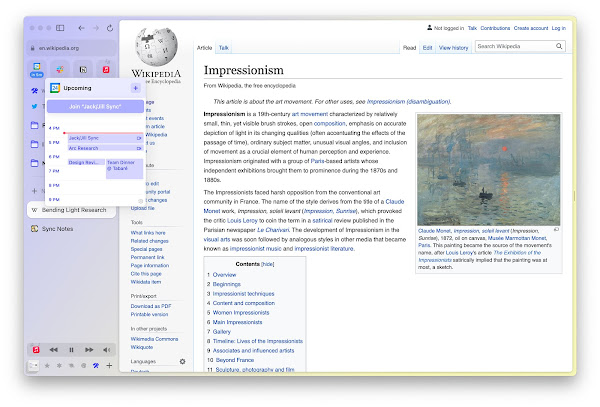Miller’s blandly named startup, the Browser Co. of New York Inc., has raised about $25 million from strategic investors such as Salesforce and big-name founder-CEOs including Stripe’s Patrick Collison and Zoom’s Eric Yuan to explore that possibility. This is the place where most people spend most of their time on their computers, but from a building-blocks level, the browser has not had a lot of brand-new thinking in a really long time
, says Instagram co-founder Mike Krieger, another investor.
The first thing a newcomer notices in Miller’s browser, called Arc, is the lack of menus or tabs across the top. Navigation tools have been pushed instead to a skinny side panel hugging the web page vertically. Users are prompted to tailor this panel to their day-to-day habits by creating spaces, say, for work or personal interests, each with its own distinct bookmarks and colors. Swiping will slide through these mini-libraries.
Arc, by contrast, isn’t defending any other business. This stance means it’s not afraid to serve fewer (or any) ads. By extension, that leaves it more open to a fundamentally different environment. Arc comes with a built-in ad blocker and promises not to track users with cookies or log their search queries. It will be free upfront; the team is looking at developing premium subscription features for enterprise users, perhaps somewhere around $12 a month, echoing the freemium model of Slack Technologies Inc., Dropbox Inc., and other productivity services.
Austin CarrImagine writing an entire article about an experimental browser with vertical tabs and not mentioning once that Edge added this as an option more than a year ago…

Another crucial detail conveniently left out is the rendering engine used – let’s be honest, it’s almost certainly Chromium, as I highly doubt a startup would have the resources to build a rendering engine from scrap when even Microsoft gave up years ago.
As for the business model… charging businesses for enterprise features is certainly a choice, but I can’t see what a small company could offer in a browser to convince companies to pay monthly fees for a software they otherwise get for free. There may be stagnation in the browser space, but that’s because building a browser is a huge investment if you start from the ground up, and there are few ways to recoup that investment by running a browser alone. That’s why current browsers are either: run by a massive tech company (Apple, Google, and Microsoft) which can cover these costs from other business lines; struggling to stay relevant while maintaining their own rendering engine (Firefox); or have adopted Chromium and various questionable business practices (see Brave mining bitcoin and the DuckDuckGo browser running Microsoft trackers on third-party sites despite promising privacy). You can tweak or ‘innovate’ the user interface all day long, but without a consistent source of income the result will likely be an acquisition by one of the big players – who knows, maybe Amazon or Facebook would like to offer their own browsers at some point?
Post a Comment